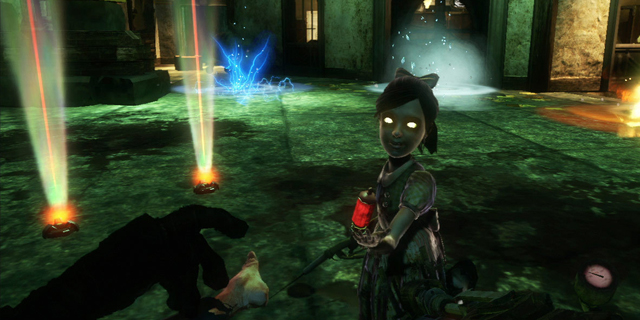
Any gamers worth their salt will scoff at the notion that graphics are the most important part of a game. Many of us grew up on the older systems: Atari, NES and the like. Even at the time, we knew the graphics weren’t the most amazing thing ever. They were, at the time, but we knew that things could get better.
Graphics are important. They can affect us emotionally in the same way that characters, storytelling and music can. They pretty much have to; you can’t taste a video game, nor can you touch or smell it. You can’t feel it physically. It’s merely graphics and audio and your input changing them, so it’s not a surprise that one of the most beautiful moments I’ve ever seen in a game is almost purely due to graphics. Not just that; anything this affecting has to come from more than photorealistic models and dynamic lighting effects. It is a scene made possible by two games’ worth of storytelling. It is a result of dozens of hours of curiosity, perseverance, appreciation, fear and wonder. It is my favorite moment of the BioShock series, and it comes in the form of you playing as a Little Sister in BioShock 2.
To get a full appreciation of the moment, I have to discuss its predecessor. Those that have played it know it to be one of the best games of this generation. Never mind that it’s now more than five years old. The underwater city of Rapture hosts a haunting journey of gunplay and plasmid fights, while also touching on subjects of Ayn Rand’s teachings and morality. Not your usual shooter tropes. Rapture is populated with many insane citizens known as Splicers, but also lumbering around are the Big Daddies and Little Sisters, the unofficial mascots of the BioShock franchise.
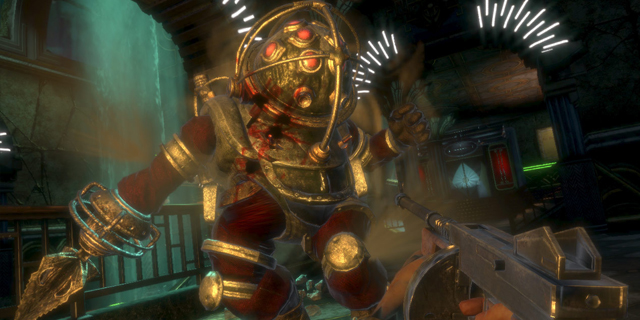
Rarely found apart, the Big Daddy and Little Sister have a touching and slightly horrifying partnership. The Big Daddy is the protector: a genetically modified monster inside an antique, armored diving suit. It usually has a giant drill as one of its arms. It won’t bother you, but if provoked, it will do everything it can to protect its charge and murder you without thought. Little Sisters are a visual contrast: you don’t see other children in the game. Rapture is the not an appropriate venue for anybody, let alone kids. They cutely refer to the Big Daddies as “Mr. Bubbles” or “Mr. B” throughout the game. If you stand and listen, you can hear them sing to their armed escorts, and will mourn their deaths if you take a Big Daddy down. Their purpose is to gather ADAM, a substance that can overwrite a person’s genetic material and give them great power, from dead bodies. It is a trademark of the BioShock series: stark contrasts in expectations and sudden, violent surprises.
The first time you see a Little Sister stab a dead body with her dirty syringe, you’re not sure what to think. Isn’t this a little girl? Wasn’t she singing about Teddy Bears a few moments ago? What are they doing in this wet, dingy, impossible city? Where do they go when they crawl into those holes? As they’re hoisted up by the Big Daddies in a manner that can only be described as caring, your curiosity grows. When you confront the larger of the two, the Big Daddies will likely drill your ribcage inside out. BioShock doesn’t exactly let you relax, or give you all the answers.
BioShock 2 has you returning to Rapture, this time in the role of a Big Daddy. This is a smart decision; some of the best parts of the original involved planning attacks, taking them down and reaping the benefits of ADAM from either rescuing or harvesting the Little Sisters. They are a unique enemy in video games; easily identifiable from both look and sound (their voiceless grunts are as an angry tree mixed with a surprisingly-vocal whale), original in design and function and somewhat lovable. Almost innocent. After all, you have to make the first shot. They don’t hunt you, you hunt them. All they’re doing is protecting a small girl from threats. Even though they’re mentally conditioned to do so, you can’t help but feel a small bit of admiration. They’re on par with the Colossi of Shadow of the Colossus in that they are the characters connected with the franchise, instead of the hero you control.
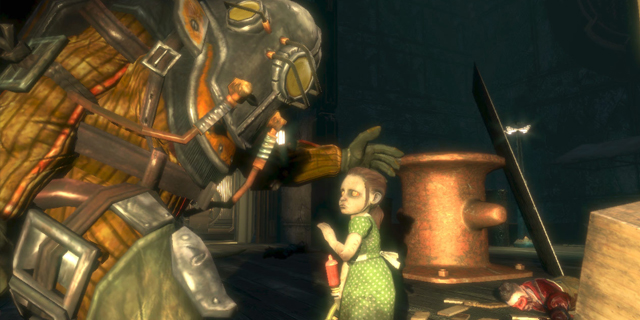
The setting of Rapture in BioShock 2 is much the same: cracks in windows lead to leaky hallways, creepy combinations of lighting and crumbling architecture make you feel uneasy, if not impressed. Your enemies this time are the Big Sisters, but that’s not the contrast I’m talking about.
There is a sequence near the end of the game where you actually get to play as a Little Sister. This is not an uncommon switch in games, where you are challenged to play as a weaker character than the main hero. It is usually designed as a stealth mission, or enabling you to access areas you couldn’t as the larger, more powerful protagonist. These sections typically don’t last long and don’t add much to gameplay, other than removing most of your attacks and creating a sense of urgency to avoid enemies. BioShock 2, for the most part, stuck with this formula. The section as a Little Sister doesn’t take a long time to complete. You are far less powerful than the main hero. It only happens once. But 2K Marin, the developer, added one twist that made it my favorite part of the game.
Not only do you play as the Little Sister, you see Rapture through her eyes. This doesn’t just mean you’re shorter, it means Rapture is transformed. A little girl’s imagination is on full display: the city is no longer a destitute, former utopia covered with slimy walls and metal flooring. It is a beautiful, elegant place. Long red carpets. Hardwood floors. Elaborately draped pearl-white curtains, everywhere. Padded red doors. Light welcomes itself through the large windows, without the usual murky water to block the view. Everything seems bathed in gold. This is an astounding place, one that you really want to visit. You don’t want this to end.

How did the team do this? Not only did it create a most visually stunning area, but it also jolted the gamers with an unexpected shock of appreciation. We just played through 25 hours (across two games) of a desolate, frightening place. People jump out of the shadows and try to kill you. Putrid water is everywhere. There is no control, only chaotic loss. And here you are playing as a Little Sister. And you see what they see. And you finally understand why they sang to Mr. Bubbles. Why they spoke of angels before, when all you saw was hell. Enemies all of sudden look like they’re attending a ball in their party dresses and tuxedos. Candlelight replaces the unreliable neon signs.
Our curiosity has been satiated. We know what it looks like when the Little Sisters get hoisted into the tunnels. We know what they see. It is a stroke of genius, how could we possibly not think that a change in perception would lead to… well, a real change in perception? What, did we think we’d just be a bit shorter?
Most say that the original BioShock was better than the sequel, and they’re probably right. But the visual contrast we see as the Little Sister is the icing on the cake of an already-good game. This was a moment I would never forget: a true, artistic risk right in front of us. When the perception is shattered, we are reminded how grim Rapture really is. I want to go back and see it with the child’s eyes, thank you very much. Can’t I go back?
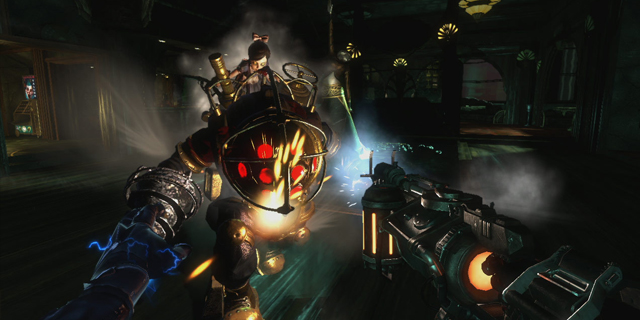
Games would do well to take note of this scene. Modern military shooters have been criticized for not having a deep enough color palette; jokes of “a million shades of grey and brown” run rampant through the forums. But it’s more than that. Video games must show a balance between their worlds and a contrast to give viewers the full impact.
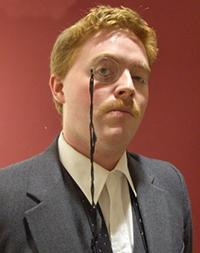 I was in a theatrical production at the local community theater in 2008. I looked ridiculous! I had to wear a painful monocle, and an equally painful mustache. The play had two very different acts: Act 1, which had four women plan to escape to Italy for a vacation (without men, but that doesn’t last long) which leads to all of them discovering new things about themselves that they wouldn’t have found in dreary, wet London in the middle of winter. The set was boring; gray walls and a single window to show a rain effect. It was dark and drab, and didn’t look nearly as good as Rapture, but you get the idea.
I was in a theatrical production at the local community theater in 2008. I looked ridiculous! I had to wear a painful monocle, and an equally painful mustache. The play had two very different acts: Act 1, which had four women plan to escape to Italy for a vacation (without men, but that doesn’t last long) which leads to all of them discovering new things about themselves that they wouldn’t have found in dreary, wet London in the middle of winter. The set was boring; gray walls and a single window to show a rain effect. It was dark and drab, and didn’t look nearly as good as Rapture, but you get the idea.
When the curtain lifted for the beginning of Act 2, the audience clapped. Here they were, transported to Italy. The set was marvelous; wisteria covered the (fake) marble arches. The windows had quaint blue covers, the doors looked like they never closed and the inhabitants never wanted them to. A large, open courtyard meant the actors had room to move and breathe. We were just as happy to bid London farewell as the crowd. It was the visual contrast, combined with the audience’s surprise and the skill in which the set was presented. This sort of trick is not new, but it felt fresh in BioShock 2. I am giddy thinking about the visual possibilities in next entry in the BioShock series, and we thankfully won’t have to wait long.



















